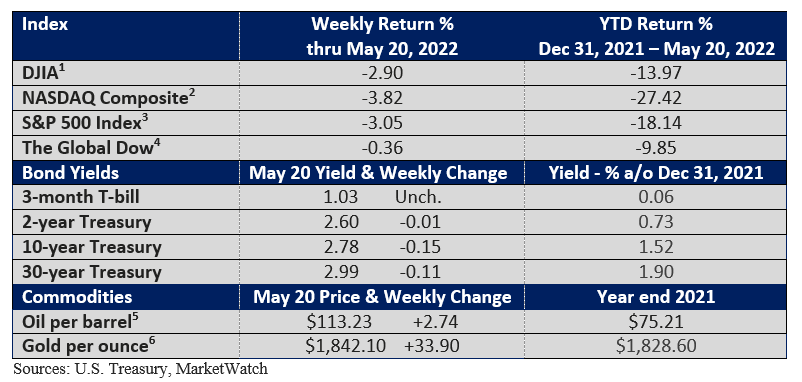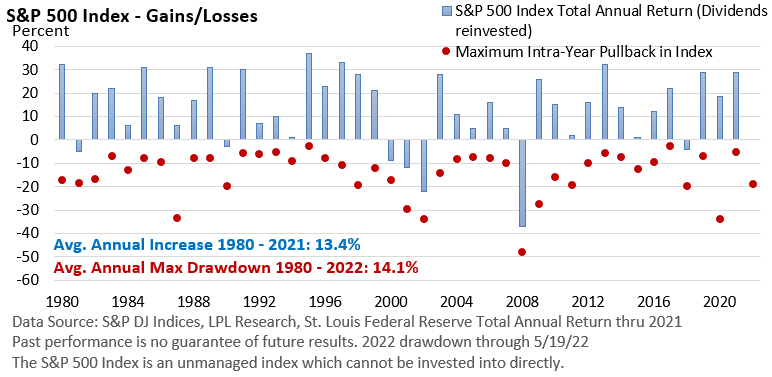High Anxiety
Investors grappled with several conflicting events last week. Given the negative sentiment in today’s environment, the market latched on to the glass-half-empty scenario.
On a favorable note, retail sales compiled by the U.S. Census Bureau were strong in April. And it wasn’t simply April. Numbers have been strong this year despite rising prices. So far, the consumer hasn’t rolled over.
We don’t like higher prices. But for the most part, we complain as we buy. In fact, when the report was released on Tuesday, there was some chatter that the consumer might be too strong.
But a day later, investors were wrestling with weak numbers from two large retailers.
Walmart (WMT $119) and Target (TGT $155) released gloomy Q1 numbers last week. According to CNBC, both companies posted better-than-expected sales.
However, both companies missed analyst earnings’ forecasts by a wide margin. Part of it was supply chain, but sharply higher transportation costs played a big role.
Two large retailers couldn’t completely pass along higher costs and were forced to partially absorb high prices for fuel and freight. Moreover, investors began to fret that rising costs could force additional downside earnings surprises at other firms.
Fed Chief Powell also commented to the Wall Street Journal last week that we need to see “inflation coming down in a clear and convincing way (my emphasis), and we’re going to keep pushing until we see that.”
As the graphic illustrates, pullbacks are a normal part of investing. In most years, the S&P 500 Index advances.
Volatility may be rooted in different conditions, but it is not unusual. We can’t predict a bottom, but as we’ve seen in the past, investors attempt to anticipate future events. When the news improves, stocks have usually already reacted.
If you have any questions or would like to discuss any other matters, please let me know.
Clark S. Bellin, CIMA®, CPWA®, CEPA
President & Financial Advisor, Bellwether Wealth
402-476-8844 cbellin@bellww.com
All items discussed in this report are for informational purposes only, are not advice of any kind, and are not intended as a solicitation to buy, hold, or sell any securities. Nothing contained herein constitutes tax, legal, insurance, or investment advice. Please consult the appropriate professional regarding your individual circumstance.
Stocks and bonds and commodities are not FDIC insured and can fall in value, and any investment information, securities and commodities mentioned in this report may not be suitable for everyone.
U.S. Treasury bonds and Treasury bills are guaranteed by the U.S. government and, if held to maturity, offer a fixed rate of return and guaranteed principal value. U.S. government bonds are issued and guaranteed as to the timely payment of principal and interest by the federal government. Treasury bills are certificates reflecting short-term (less than one year) obligations of the U.S. government.
Past performance is not a guarantee of future results.
Different investments involve different degrees of risk, and there can be no assurance that the future performance of any investment, security, commodity or investment strategy that is referenced will be profitable or be suitable for your portfolio.
The information has been obtained from sources considered to be reliable, but we do not guarantee that the foregoing material is accurate or complete. The information contained in this report does not purport to be a complete description of the securities, markets, or developments referred to in this material.
The information contained is not a complete summary or statement of all available data necessary for making an investment decision and does not constitute a recommendation.
Before making any investments or making any type of investment decision, please consult with your financial advisor and determine how a security may fit into your investment portfolio, how a decision may affect your financial position and how it may impact your financial goals.
All opinions are subject to change without notice in response to changing market and/or economic conditions.
1 The Dow Jones Industrial Average is an unmanaged index of 30 major companies which cannot be invested into directly. Past performance does not guarantee future results.
2 The NASDAQ Composite is an unmanaged index of companies which cannot be invested into directly. Past performance does not guarantee future results.
3 The S&P 500 Index is an unmanaged index of 500 larger companies which cannot be invested into directly. Past performance does not guarantee future results.
4 The Global Dow is an unmanaged index composed of stocks of 150 top companies. It cannot be invested into directly. Past performance does not guarantee future results.
5 CME Group front-month contract; Prices can and do vary; past performance does not guarantee future results.
6 CME Group continuous contract; Prices can and do vary; past performance does not guarantee future results.


